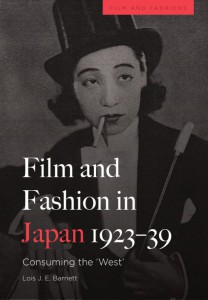Film and Fashion in Japan, 1923-39
Consuming the 'West'
by Lois Barnett


Average rating: ![]()
| 0 | rating | |
| 0 | rating | |
| 0 | rating | |
| 0 | rating |
Your rating: -
Book Presentation:
Examines Western-inspired fashion objects in Japanese cinema between 1923 and 1939
• Consults varied primary Japanese-language source material, such as visual analysis of extant films; film fragments and stills from the era; advertising ephemera such as film posters and match boxes; and various print-based materials
• Provides film analysis and synopses of many Japanese films which are not yet commercially available and/or subtitled in English
• Concentrates equally on depictions of menswear and womenswear – there is currently a bias towards depictions of women’s styles in both fashion and film studies
• Discusses the history of issues highly relevant to today’s media climate in a non-American and non-European context
• Presents fashion as a means of coding identities both on- and off-screen – case studies include the Modern Girl (the Japanese variant of the Hollywood flapper), the Modern Boy (a foppish masculine archetype), the modernising Japanese housewife and the healthy sportsperson.
• Discusses LGBT identities and the usage of fashion to depict them in both Japanese and Hollywood cinemas
Film and Fashion in Japan, 1923-39 examines the interaction between the audience member and Japan's film and fashion industries, focusing on Western-inspired fashion objects as opposed to indigenous Japanese items. Taking an interdisciplinary approach, Barnett examines the semiotics of dress onscreen within Japan’s transcultural media climate, consulting not only film- or fashion-related theoretical bases but also historical and gender-based approaches.
The work consults surviving films, print media and advertising materials, allowing insights into lost films and the period's thriving commercial context. It focuses on the expressive Modern Girl image (the Japanese equivalent of the Hollywood flapper); sportswear and hybridised dress styles (which combined Japanese and Western-influenced aesthetics) and their relationship with body; and menswear in the early work of the director Ozu Yasujirō. This book discusses the role of fashion consumption in defining emergent modern identities and their relationships with new spaces, questioning their arising in the Japanese context and within the global sphere.
About the Author:
Lois J. E. Barnett is a Postdoctoral Research Associate at the School of Oriental and African Studies, University of London (SOAS).
Press Reviews:
This book is a fascinating examination of the market condition for Japanese cinema in a major period of transition. Through detailed historical research it pays attention to the intersection of the film and fashion industries to excavate a vital story of changing sartorial styles and their cultural and social meanings.– Julian Stringer, University of Nottingham
See the publisher website: Edinburgh University Press
> On a related topic:
Transpacific Convergences (2022)
Race, Migration, and Japanese American Film Culture before World War II
by Denise Khor
Subject: Countries > United States
Powers of the Real (2019)
Cinema, Gender, and Emotion in Interwar Japan
Nippon Modern (2008)
Japanese Cinema of the 1920s and 1930s
Imperial Screen (2003)
Japanese Film Culture In The Fifteen Years War, 1931-1945
Designing Hollywood (2023)
Studio Wardrobe in the Golden Age
Shoe Reels (2021)
The History and Philosophy of Footwear in Film
Dir. Elizabeth Ezra and Catherine Wheatley